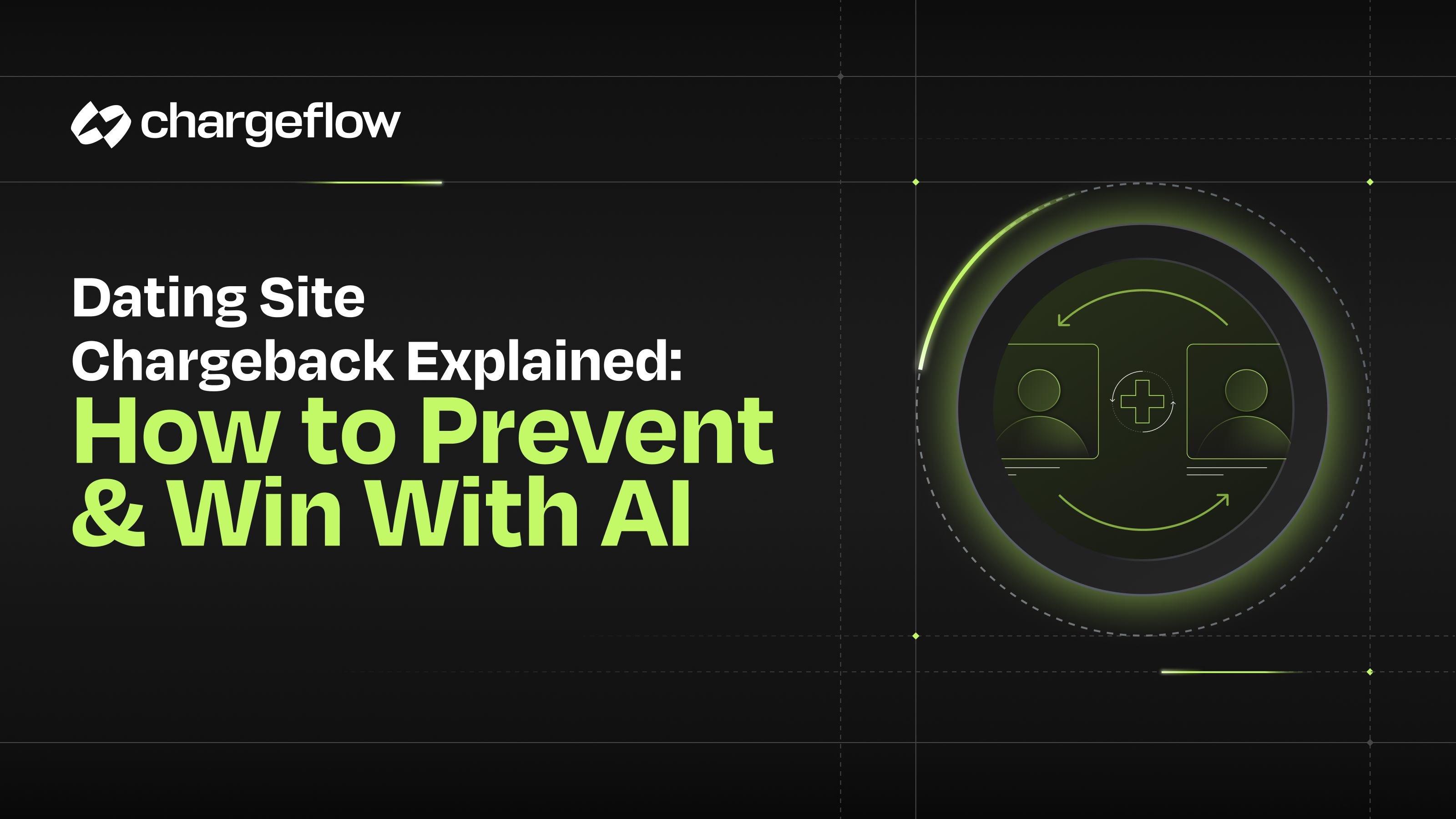Customer Service Chatbot: Can You Protect Chargebacks with this AI tool?

Chargebacks?
No longer your problem.
Recover 4x more chargebacks and prevent up to 90% of incoming ones, powered by AI and a global network of 15,000 merchants.
Discover the truth about using Chatbots to handle chargebacks in this informative article. Separate myth from reality and streamline your payments.
As customers have become more tech-savvy, customer service needs to accommodate their needs quickly and efficiently.
Chatbot AI technology is one innovation that has risen to meet this challenge - providing businesses with an automated way to answer customer inquiries without the need for human staff members to monitor conversations around the clock. But can you protect chargebacks using this tool?
In this blog post, we'll delve into the crucial role of a chatbot AI in managing your customer service strategy and mitigating fraudulent chargeback risks.
The Role of Customer Service Chatbots in Reducing Chargebacks
The role of customer service chatbots in reducing chargebacks cannot be overlooked, as these modern technological tools hold immense potential in both preempting disputes and addressing them efficiently.
As an integral part of many businesses' customer service strategies, chatbots can effectively engage with customers in real time, assisting them in resolving queries and concerns that may otherwise escalate into disputes, and consequently, chargebacks.
By providing instant support and guidance, chatbots address misunderstandings or errors that frequently trigger dissatisfaction among customers. Moreover, these AI-powered chatbots also play a significant role in detecting and preventing fraud.
With their ability to analyze significant amounts of data and recognize suspicious activities, chatbots can identify potential threats and help companies respond accordingly to safeguard their interests.
In short, using customer service chatbots serves as a proactive measure in mitigating the risk of chargebacks while ensuring a seamless and satisfactory customer experience.
The Benefits of Customer Service Chatbots
The benefits of customer service chatbots are significant and have a profound impact on businesses in various sectors. Firstly, they enhance the customer experience by providing instant responses and support 24/7, ensuring no query goes unanswered.
This accessibility and timely communication not only resolve customers' concerns swiftly but also cultivates trust and satisfaction. Secondly, chatbots augment efficiency and productivity by automating routine tasks, enabling customer support teams to focus on more complex issues that require human intervention.
By streamlining response management, chatbots contribute to both time and effort optimization. Moreover, the integration of chatbots leads to substantial cost reductions for companies. When compared to hiring, training, and retaining full-time support staff, adapting to an AI-powered customer support system corresponds to lower operational expenses.
Lastly, the positive customer experience and time saved using chatbots directly Influence increased sales and revenue. Chatbots facilitate quicker problem resolution and promote engagement that customers appreciate, increasing the likelihood of repeat business and fostering loyalty.
Features of Customer Service Chatbots That Can Help Prevent Chargebacks
Customer service chatbots can play a crucial role in preventing chargebacks, which occur when a customer disputes a transaction and demands a refund from the merchant. By integrating certain features into the chatbot, businesses can help reduce the likelihood of chargebacks occurring. Let's explore some of these key features in more detail:
1. Real-time monitoring and alerts
A customer service chatbot can be programmed to monitor transactions in real-time and alert the business if it detects any unusual activity. For example, if a customer makes multiple purchases in a short amount of time or if a purchase is made from a different location than usual, the chatbot can flag this as a potential issue and alert the business. This allows the business to investigate the transaction and take appropriate action to prevent a chargeback.
2. Automated dispute resolution
Chatbots can also help automate the dispute resolution process, allowing customers to quickly and easily resolve any issues they may have with a transaction. By providing a simple and efficient way for customers to communicate with the business and resolve their concerns, the likelihood of chargebacks occurring can be reduced.
3. Fraud detection and prevention
One of the most common reasons for chargebacks is fraud, where a third party makes a purchase using stolen credit card details. Chatbots can be equipped with fraud detection algorithms that can flag suspicious transactions and prevent them from being processed. This can help prevent chargebacks and protect the business from fraudulent activity.
4. Transaction tracking and verification
A customer service chatbot can also help track and verify transactions to ensure they are legitimate. For example, if a customer claims they did not receive a product or service, the chatbot can verify if the transaction was completed and if the product was delivered. This can help prevent false chargebacks and protect the business from unnecessary losses.
Implementing a Customer Service Chatbot for Chargeback Prevention
1. Selecting the right chatbot provider
Implementing an effective customer service chatbot for chargeback prevention is a crucial step to ensure seamless and prompt support to your customers. Selecting the right chatbot provider involves considering several key factors. Firstly, evaluate the ease of integration with your existing systems and the flexibility of the platform to adapt to future technological advancements.
Examine the provider's track record in terms of customer satisfaction, chatbot efficiency, and overall reliability. Analyzing features like language support, the ability to handle complex queries, and the level of customization available is essential in choosing the chatbot that best fits your organization's unique needs.
Additionally, ensure that the chatbot complies with data privacy regulations to safeguard your business reputation and customer trust. With thorough research and attention to detail, selecting the right chatbot provider will significantly enhance your customer experience, drive loyalty, and aid in avoiding chargeback issues.
2. Integrating the chatbot with existing systems
By seamlessly connecting the chatbot to platforms such as CRM, payment gateways, and fraud detection systems, businesses can enhance their customer service capabilities and simultaneously reduce the risk of fraudulent transactions.
The integration process considers the compatibility of the chatbot with current systems, ensuring that data flows smoothly between platforms for greater accuracy, efficiency, and automation.
Furthermore, incorporating AI-driven technologies and machine learning algorithms into the chatbot allows it to continually improve its performance, understanding customer needs while preventing chargebacks.
Ultimately, a properly integrated chatbot provides a streamlined customer experience, facilitating proactive measures against fraud and fostering customer trust and loyalty.
4. Measuring the effectiveness of the chatbot in reducing chargebacks
Measuring the effectiveness of a customer service chatbot in preventing chargebacks is essential in analyzing its impact. Successful implementation of the chatbot should lead to reduced customer complaints or need for offline efforts from staff, thereby leading to bottom-line improvements in terms of cost savings.
Furthermore, it should also result in higher customer satisfaction due to smoother resolution of disputes as well as improved processing speed, and greater accuracy in evaluating user queries.
Data and analytics can be used by businesses to measure both financial and non-financial benefits from the implementation of the chatbot– these might include cost savings, the number of support tickets resolved, customer retention rates, the average time taken for resolution, etc.
Additionally, post implementations surveys can be used to analyze user engagement with the service chatbot by collecting direct feedback from customers on their interactions with it. This will help businesses fine-tune their product and make adjustments that would further boost experiences while at the same time reducing chargeback incidences.
Challenges and Limitations of Customer Service Chatbots for Chargeback Prevention
There are several challenges and limitations to using chatbots for chargeback prevention. In this article, we will discuss some of the most important ones.
1. Accuracy and reliability of chatbot responses
One of the biggest challenges with chatbots is ensuring that they provide accurate and reliable responses to customer queries. In the case of chargeback prevention, chatbots need to be able to quickly and accurately identify the reason for the customer's dispute and provide a resolution that satisfies both the customer and the business.
To address this challenge, businesses need to invest in robust chatbot training and testing programs. Chatbots should be trained on a large dataset of historical customer interactions and should be continuously monitored and updated to ensure that they are providing accurate responses. In addition, chatbots should be able to escalate complex or high-risk cases to human customer service agents.
2. Integration with human customer service agents
Chatbots are not meant to replace human customer service agents but to augment their capabilities. In the case of chargeback prevention, chatbots can handle routine queries and simple disputes, leaving more complex cases to human agents.
To ensure seamless integration between chatbots and human agents, businesses need to invest in technology that allows for easy handover between the two. Chatbots should be able to transfer customer conversations to human agents without losing context, and human agents should be able to access chatbot transcripts and customer history to provide personalized support.
3. Maintaining customer trust and satisfaction
Chatbots are often seen as impersonal and lacking empathy, which can lead to a decrease in customer satisfaction and trust. In the case of chargeback prevention, customers may feel frustrated or misunderstood if chatbots provide generic or unhelpful responses.
To address this challenge, businesses need to invest in chatbot design and development that prioritizes customer experience. Chatbots should be able to understand customer intent and provide personalized responses that address their specific concerns. In addition, businesses should provide customers with the option to speak with a human agent if they feel that their concerns are not being addressed.
4. Cost and resource allocation
Implementing chatbots for chargeback prevention can be costly, particularly for small and medium-sized businesses. Chatbot development and training require significant resources, and businesses may need to invest in additional technology to ensure seamless integration with existing customer service channels.
To address this challenge, businesses should carefully consider their budget and resource allocation when implementing chatbots. They should also explore options for outsourcing chatbot development and maintenance to third-party providers, which can help to reduce costs and ensure high-quality chatbot performance.
Final Thoughts
In conclusion, having a customer service chatbot can be a great tool to help reduce the risk of chargebacks. With the right features implemented, it can help prevent fraudulent purchases and even fight disputes in case a dispute occurs.
Companies that have implemented customer service chatbots have seen a decrease in chargebacks and better overall customer experience. With that said, there are some challenges and limitations that should be taken into account before you decide to implement such a solution. Regardless, it’s worth considering as it has been proven to deliver positive results.
Prevent chargebacks from hurting your business with Chargeflow autopilot solutions - an AI-based solution equipped with cutting-edge preventive measures to help protect you against unwanted chargebacks. Join thousands of e-commerce businesses using our tailored solutions for their businesses today and start seeing results!

Chargebacks?
No longer your problem.
Recover 4x more chargebacks and prevent up to 90% of incoming ones, powered by AI and a global network of 15,000 merchants.






























.png)








